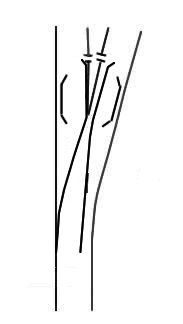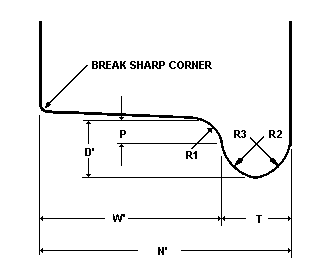|
wheels, flanges and back to backs
Wheels of railways are a great deal more
complex than first meets the eye. The angles of the tread and the radius
between the flange and the tread (blue area) are very carefully worked out
to minimise friction and wear. Full size railways even use different
materials for parts of the wheel profile. At regular intervals the wheels
are built up again with weld and ground down to specification.

When model railways first began to become
popular, no one cared very much about accurate rendition and concern was
that the train stayed on the tracks. Wheel profiles could be described as
'agricultural'.

Many model railway manufacturers, have over
the years developed their own standards and for a period of time, 00 scale
trains could not properly run together. It was an excellent way to force
customers to remain loyal to Hornby, Trix or Triang, I suppose. The
problem was solved by Wren 'universal two or three rail track' by
developing points that did not operate like the real thing at all.

Gradually, due to company takeovers, some
standards became established in OO scale. Sadly, the scale included track
was was a scale several inches too narrow. The Europeans from the start
elected to build models in H0, which rendered the track gauge of 16.5mm
correct. Nevertheless, they took a long time to standardise wheel,
coupling and track standards. The whole sorry story of 00 is proof to me
why Britain will always be a reluctant member of the EEC.
Things improved with the introduction of Peco
track and even a chaired track system became available from Chairway.
Gradually, serious modellers in Britain have
established more scale track gauges. EM gauge, (18mm gauge) and
subsequently scales like protofour, (18.83mm). This is fine scale.
In these new scales, flange depths have been
reduced to scale and for the first time in the UK, model 4mm/ft trains
look right.
Most 4mm/ft modellers still use the 00 narrow
gauge track and run their trains with deeper flanges than scale and
heavier rail. This is course scale.
Similar differences exist between fine and
course scales in gauge 0, 1 and upwards.

Points are now built as in prototype
practice. As the frog is fixed, outer check rails are needed to
guide the wheels and prevent them hitting the point of the frog which will
result in a derailment. The means that the gap between the stock rail and
the check rail have to be specified and accurate. Likewise, the back to
back measurements of the railway wheels have to be accurately set. Below
are shown the dimensions for fine scale 00 gauge. Back to back
measurements must be checked for all wheels. A gauge can be purchased for
most scales.

Some commercial points, such as those of
Peco, have the frog set in plastic so when a wheel cross the gap at the
frog, the flange is supported. Sadly, wheels do not all have flanges set
to a standard depth and some, such as Riverossi N scale, have such deep
flanges that they will jump at the frog. It is then necessary to excavate
the plastic to allow the wheel to cross freely (or throw the Riverossi
away).
|
4mm
two foot narrow gauge |
Early narrow gauge modellers had it all
to do themselves. For those modelling 2ft gauge railways, a track gauge of
8mm was sensibly chosen. From the Hatfield, UK, came a company called Lone
Star. They built die cast toys including things such as cap pistols. A
range of push-along trains were released with a track gauge of 8mm.
Eventually these were motorised and a new gauge of 9mm was selected. It
was called 000 which was the start of the popular N scale.
These days, most of use who model in narrow
gauge, employ the N scale gauge as standard although a few people do model
in fine scale and 8mm gauge.
Models of three foot/metre gauge railways
used TT scale track, (12mm gauge).
There is a standard for N gauge which is
relatively fine scale. It was set by the NMRA (National Model Railroad
Association).

| Norm/standard |
Gmin
Gmax |
Cmin
- |
-
Smax |
-
Fmax |
Hmin
- |
-
Pmax |
| NMRA S-3.2 |
8.97
9.32 |
8.20
- |
-
7.52 |
-
0.76 |
0.56
- |
-
7.92/8.05 *) |

| Norm/standard |
-
Kmax |
Bmin
- |
Nmin
- |
Tmin
Tmax |
-
Dmax |
P
- |
| NMRA S-4.2, RP25 |
-
8.20 |
7.54
- |
1.80
- |
-
0.51 |
-
0.56 **) |
0.18
- |

| Norm/standard |
N' |
T |
W |
D' |
P |
R1 |
R2 |
R3 |
| NMRA RP25 |
1.83 |
0.51 |
1.32 |
0.51 |
0.18 |
0.20 |
0.23 |
0.23 |
Rather sadly, this
standard did not really travel well to Europe and there is still a
ghastly profusion of course wheel standards out there. So those working
in H0e and 009 are left with having to fiddle around with our pointwork
to find some happy compromise, unless we are absolutely brutal and insist
on one wheel standard. Sadly, this is not always possible for those of
use who have large collections of stock. Peco track seems to have found
some reasonable compromise although the crazy track points should be
avoided at all costs.

early Minitrix pizza cutter flanges

|